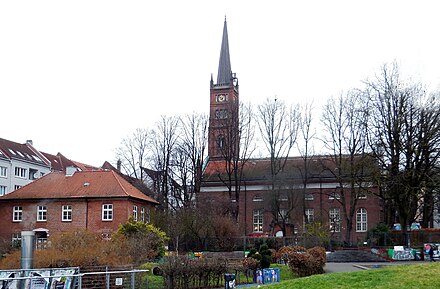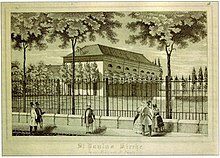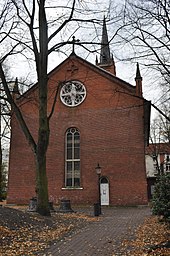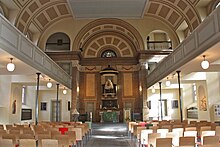St. Pauli Church (Hamburg-Altona-Altstadt)
The Evangelical Lutheran Church of St. Pauli is located in the Hamburg district of Altona-Altstadt on Pinnasberg Street. Until the district boundaries were changed in 1949, the property belonged to the St. Pauli district , for which it was the eponymous church in 1833.
Predecessor church
The predecessor of the church was a small half-timbered church from 1682, already consecrated to the apostle Paul , which was built for the suburb that ran outside the Hamburg city walls. It was light and simply constructed, with only a massive stone wall on the west and a small wooden bell house on the northeast corner. Like the whole district , it was burned down in January 1814 during the Napoleonic Wars . A small part of the inventory could previously be recovered, which is now in the church that was built afterwards.
Building the church
The new building, partly financed by French reparations payments, was built in 1819/1820 according to plans and under the direction of Carl Ludwig Wimmel as a classical hall church with lateral galleries and an altar niche. The former roof structure as a barrel vault was on all sides hipped . In the same year, the two buildings flanking the church in the south (at that time as a pastorate, school and sexton's apartment) were also implemented. In all of the original designs, Wimmel envisaged an initially large, later low, neo-classical tower , which, however, was not built because the parish could not raise the necessary funds. The church bell hung in a simple wooden frame on the eastern side of the roof approach.
From 1842 onwards, the community began collecting for the construction of a church tower, which quickly resulted in larger sums. After the fire in Hamburg , however, it was decided to use all the funds that had been collected so far to support the rebuilding of St. Petri and St. Nikolai . In 1847, the construction of a tower was postponed again in favor of a new school building in Antonistraße. From 1850 the pastor at the time, Carl Heinrich Behrens, campaigned intensively for the construction of a tower, and in the following years he managed to obtain the necessary funds for it. The building of the tower was completed in 1864 and has now been modified in the neo-Gothic style by a design by the architect Max Wallenstein . On December 27, 1864, the community inaugurated the tower. At the same time, the originally classical east facade was removed, the roof shape was changed and two gables were built for it.
Exterior architecture

The floor plan and facade of the church followed the scheme for small church buildings that was common during the construction period. Wimmel's designs for the exterior are heavily influenced by churches by the Danish architect CF Hansen . This is particularly evident in the structure of the side facades with rectangular and semi-arched windows and the multi-profiled cornice . The development of the property also corresponds to the typical symmetry of the time, the centrally arranged church with a strict east-west orientation is supplemented by four outbuildings on the corners of the property.
The entire church building has an area of about 30 × 18 m , the tower with an almost square base area of 5 × 5 m is around 35 meters high.
From the four-part ringing , the big bell had to be delivered as a metal donation by the German people in World War I , the next smaller bell followed this path in World War II . In the meantime, this church got a bell from the Michel as a replacement and the community had a cast steel bell made and hung. The two bells installed on top of each other on the outside of the spire, which indicate the quarter hours and hours, are the only original ones from the year the church was built. The smallest is from 1549 and its origin is unknown.
When new bells could be cast after the Second World War, the parish placed the remaining bells on the east side of the church on the ground floor. In 2016, a company renewed the iron clapper (also known as the hammer or bat ) of the hour bell. In addition, the church tower clock had to be completely replaced.
Furnishing
With the design of the interior, Carl Ludwig Wimmel presented a special achievement of his own. The bright gallery hall with its clear proportions is oriented towards the central pulpit altar and the richly structured east wall. The chancel is flanked by two side rooms and forms a rectangular niche, which is closed at the top by a semicircular arch. The opposing curved galleries on the west side are a defining feature of the space. The slender iron columns that support the galleries are striking, and the architect was only able to make a final decision in late drafts.
On the side walls of the interior there are various paintings by locally known pastors and displays of the coats of arms of pastors and church jurists . After a renovation in 1993, only two short rows are left of the original rows on the western wall, the former Senate bench (recognizable by the Hamburg coat of arms) and the former communion bench.
The oldest parts of the interior are from the late 17th century and were already in the first church. The base of the baptismal font is from 1693, its brass bowl is from 1744. During the renovation in 1993, the cover of the baptismal font disappeared. It was then replaced by a new one, which is an extensive copy of the old piece, on which, however, the two dates 1693 and 1993 can be found as well as allusions to the character of the modern St. Pauli as an entertainment district. The wooden statue of the Apostle Paul is dated to the end of the 17th century. The crucifix from 1690 that connects the two galleries today is possibly the work of the baroque sculptor Christian Precht .
organ

The organs of the two consecutive church buildings have an eventful history. The biographer of the organ builder Arp Schnitgers , Siwert Meijer, who in the 19th century was able to fall back on documents from Schnitger's workshop that were still preserved at the time, passed on Schnitger's statement that he had built "1687 op den Hamburger berg een small organ". Otto Diedrich Richborn , a former employee of Schnitger, replaced his organ with a new one as early as 1718–1721. Richborn probably did not take over anything from Schnitger's organ, because he took the previous instrument for 100 marks lüb. in payment, and the contract received does not refer to any acquisitions from the old portfolio. A surviving design drawing of the case shows that the exterior of the Richborn organ followed Schnitger's design principles. Johann Precht (1665–1730) was to produce the carvings .
The fire in the church on January 3, 1814 triggered the construction of the new church, but the Richborn organ and other interior had been cleared out the week before and was therefore initially preserved. The organ builder Johann Heinrich Wohlien set it up again with a few changes in the register inventory (see disposition). The Richborn organ was inaugurated in this form on March 4, 1821.
Disposition 1721 or 1821
The disposition follows the original spelling in Contract 1718. Registers in brackets denote registers that Wohlien built in 1821, which replaced the previously mentioned registers by Richborn.
|
|
|
|||||||||||||||||||||||||||||||||||||||||||||||||||||||||||||||||||||||||||||||||||||||
- Manual sliding coupler
- 2 Zimbelsterne (back positive)
- 1 tremulant
- 3 shut-off valves
- 4 wedge bellows
- Windchest : Manuals (Richborn), Pedal (Richborn or Wohlien)
- Remarks
- ↑ a b c English tin.
- ↑ a b Drafted beyond the contract.
- ↑ It is possible that Richborn already built the flute 4 '.
- ↑ Wohlien retained the Richborn circumference, but perhaps expanded it to Cd 1 .
In 1932 the Richborn organ was replaced by an organ made by Wilhelm Sauer (owner Oscar Walcker) , whose disposition followed Hans Henny Jahnn's ideas . This Sauer or Clemens Schultz memorial organ was rebuilt in the first half of the 20th century, but only lasted until 1968 when the weather hit it so badly that it was unplayable. As a temporary solution, an organ (I / 6) from Emil Hammer Orgelbau was put into use in the same year . In the 1990s, the Sauer organ was removed from the church and in 2007 it was given on permanent loan to the Schloss Valley Organ Foundation for the purpose of restoration .
The organ, newly built in 2011, with 20 registers on two manuals and one pedal is an instrument by the master organ builder Bartelt Immer . It is based on the shape of the Richborn organ with the changes Wohlien made when the church was built. Your disposition is:
|
|
|
|||||||||||||||||||||||||||||||||||||||||||||||||||||||||||||||||||||
Important personalities and community work
The St. Pauli congregation had two parsonages built on the church premises on Pinnasberg Street (houses number 80 and 81). The first pastor after the consecration was Hermann Gottfried Horn , before him - in the old church - was Paul Merchins (1778–1841). Pastor Horn was followed by Carl Heinrich Behrens (1805-1883) in office from 1849 until his death. The most important pastor of the church was Clemens Schultz (1862-1914), after whom a street on St. Pauli was named. Schultz was one of the founders of modern church youth work and welfare, he founded the first apprentice or assistant clubs in Hamburg as a means of pastoral and social care for young workers.
Since Clemens Schultz's work, youth work has been a focus of community work. As early as 1899, the community founded a crèche, which still exists as a day-care center . Therefore, space was left on the church property for a church school, which later continued to exist for many decades. A youth center has been in operation on Heidritterstrasse since the 1980s , the focus of which is on the integration of young people of different origins.
The area of the rather large community with 5500 members extended at the beginning of the 2010s over the districts of St. Pauli , Sternschanze and the Karolinenviertel .
In 2013, 80 refugees stayed in the community for several months. In September 2013, the original reading of Elfriede Jelinek's Die Schutzbefohlenen took place in the church , with the participation of refugees and actors from the Thalia Theater . Coordinates: 53 ° 32 '48.7 " N , 9 ° 57' 23.4" E
See also
In 1907 the Gnadenkirche (Hamburg) was consecrated as a branch church for the Karolinenviertel part of the St. Pauli district .
St. Pauli in the media
The church served as the backdrop for the film Der Hafenpastor , which was shown on September 12, 2012 in the series FilmWittwoch im Erste . The Hamburg actor Jan Fedder played the Hafenpastor Stefan Book .
literature
- Jan von Busch: The lost Schreiber organ in Koldenbüttel and its organ-building organists . In: Ars Organi . tape 66 , no. 2 , 2018, p. 73–82 (The article deals with the Schnitger organs of the St. Pauli Church (Hamburg-Altona-Altstadt) and the positive in Bergstedt ( 73-76 online , PDF).
- Cornelius H. Edskes, Harald Vogel: Arp Schnitger and his work . 2nd revised edition. Hauschild Verlag, Bremen 2013, ISBN 978-3-89757-326-0 , pp. 160 (first edition: 2009, standard work of the Arp Schnitger Society and the Stichting Groningen Orgelland, which inventories all 45 organs preserved.).
- Ralf Lange: Architecture in Hamburg . Junius Verlag , Hamburg 2008, ISBN 978-3-88506-586-9 , p. 85 f .
- Matthias Gretzschel : Churches in Hamburg: history, architecture, offers . Axel Springer Verlag , Hamburg 2000, ISBN 3-921305-92-6 , pp. 86 f .
- Günter Seggermann, Alexander Steinhilber, Hans-Jürgen Wulf: The organs in Hamburg . Ludwig, Kiel 2019, ISBN 978-3-86935-366-1 , pp. 168 .
- Friedhelm Grundmann, Thomas Helms: When stones preach . Medien Verlag Schubert, Hamburg 1993, ISBN 3-929229-14-5 , p. 88 ff .
- Gustav Fock : Arp Schnitger and his school. A contribution to the history of organ building in the North and Baltic Sea coast areas . Bärenreiter, Kassel 1974, ISBN 3-7618-0261-7 , p. 66, 76 (basic monograph on life and work, with bibliography).
- Parish of St. Pauli (ed.): Sankt Pauli Church in Hamburg 1820–1970 . Albatros Verlag, Hamburg 1970.
Archival sources
- In the State Archives of the Free and Hanseatic City of Hamburg, under the signature 512-8_XI D 7 Fasc.8 receipts for earth, bell, basin and pulpit money of the St. Paulikirche can be found
Web links
Individual evidence
- ↑ a b Church and district of St. Pauli , accessed on October 10, 2016.
- ↑ The three bells that are not made of bronze show quotes from the Bible in the shoulder.
- ^ Daniel Kaiser: New clock and new hammer for St. Pauli Church on NDR , June 3, 2016, accessed on October 10, 2016.
- ↑ The presentation here follows the main features outlined in Busch 2018.
- ↑ Cf. Edskes / Vogel 2013, pp. 219, 226. The hypothesis put forward by Edskes and Vogel as a fact that Schnitger's organ positive in Hamburg-Bergstedt is this organ has since been refuted by Jan von Busch (Busch 2018, P. 78–80.) Von Busch confirms through archival finds that the Schnitger researcher Gustav Fock correctly identified the organ on the "Hamburger Berg" with the Schnitger organ in the St. Pauli Church (cf. Fock 1974, p . 66).
- ↑ Fig. In Busch 2018, p. 81.
- ↑ Information from Busch 2018, p. 79.
- ↑ Busch 2018, pp. 77-78 and 80, indicates that older pipe material was used in a school organ built for the school in Koldenbüttel in 1831 . He gives reasons for the possibility that this pipe material could have come from the former Richborn organ in St. Pauli. The school organ is now in the Mennonite Church in Friedrichstadt .
- ↑ Information about the organ on the municipality's website. Retrieved July 14, 2018.
- ↑ Information on Paul Merchins and Carl Heinrich Behrens on the existing gravestones in the historic churchyard east of the church building. Seen and photographed by user: 44Penguins in August 2016.
- ↑ Short biography on the community's homepage. Retrieved February 22, 2012.
- ^ Entry on Clemens Schultz in the DNB . Retrieved July 5, 2012.
- ^ Entry on Clemens Schultz in the Deutsche Biographie . Retrieved July 11, 2012.
- ^ Last refuge zeit.de, July 18, 2013.
- ↑ Falk Schreiber: A Roof Over Your Head , Nachtkritik.de , September 21, 2013.
- ↑ Der Hafenpastor ( Memento of November 16, 2012 in the Internet Archive ) (accessed on December 23, 2012, 9:36 pm).
- ↑ Receipts for earth, bell and pulpit money of the St. Paulikirche. Retrieved October 10, 2016.
- ↑ The website currently (6 September 2018) does not yet contain the corrections made above in the section " Organ ", which are required due to the article Busch 2018 .








